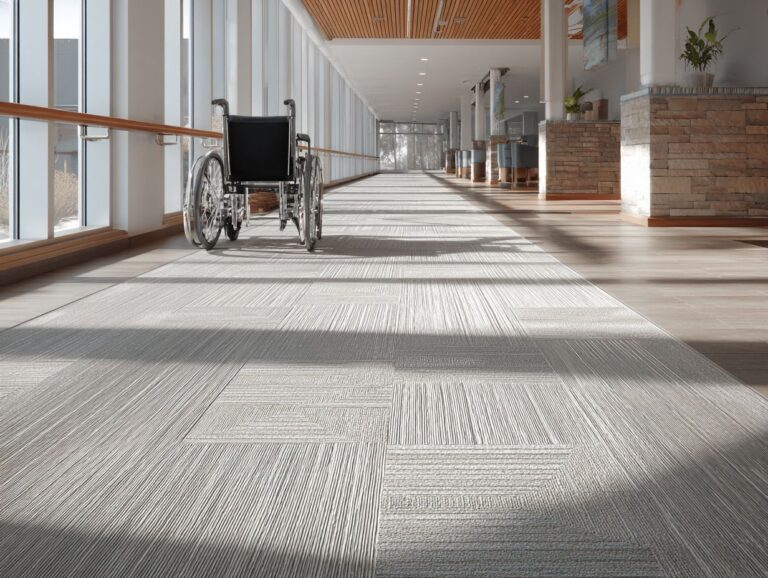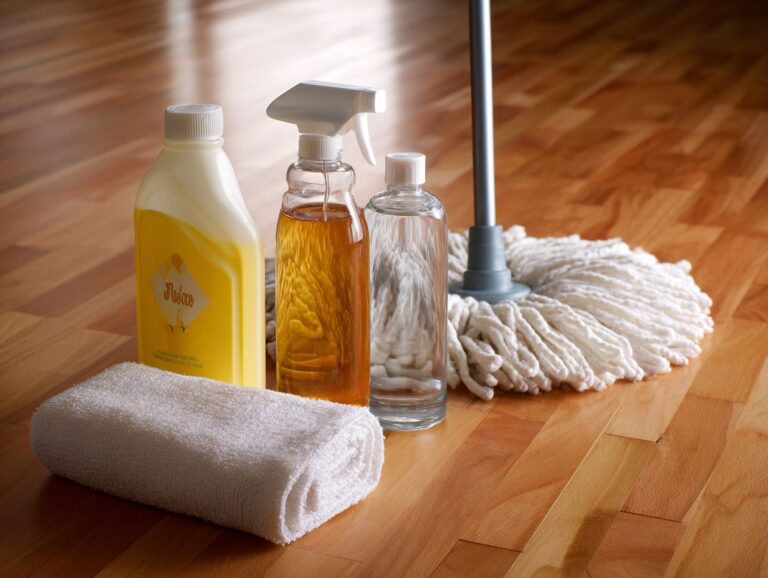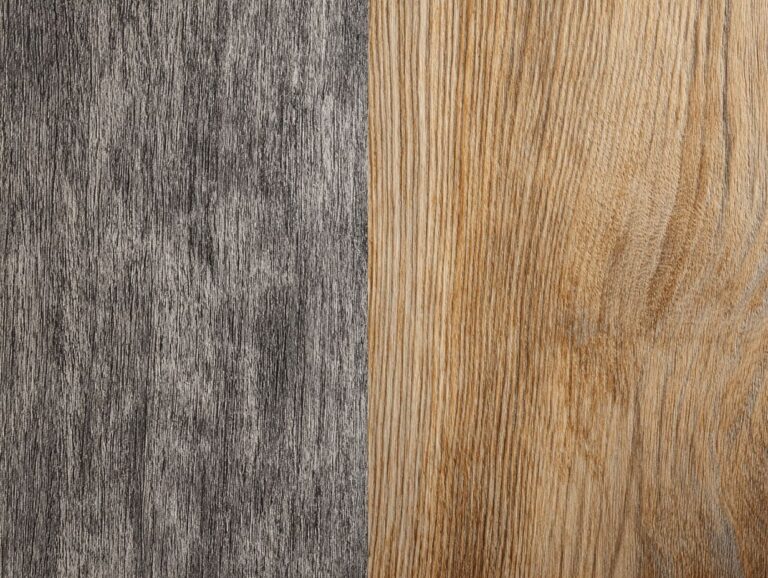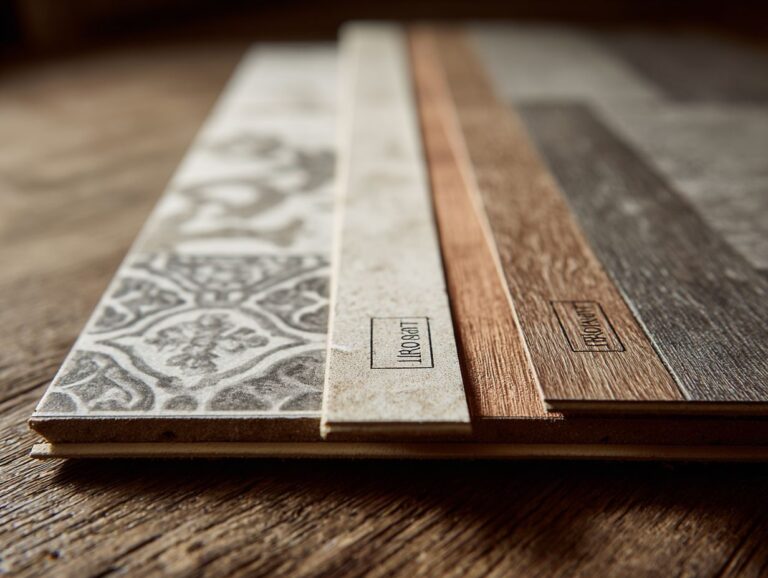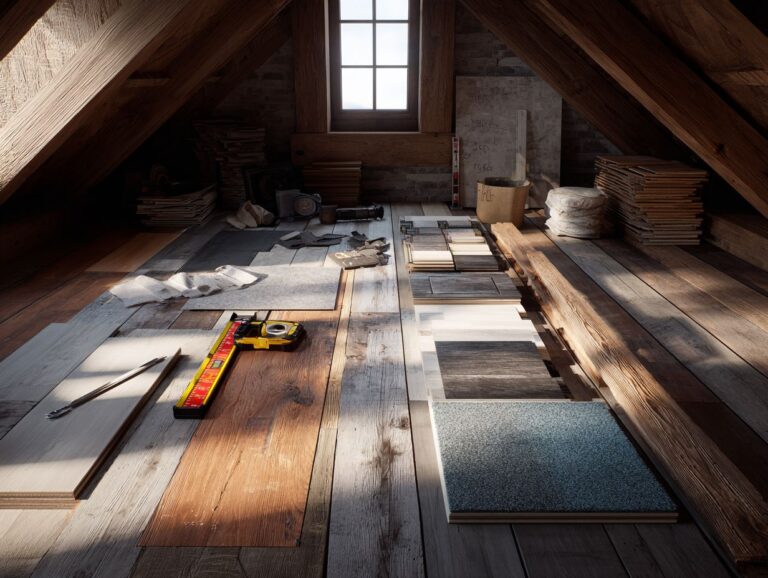Large Format Tiles – Installation Challenges and Benefits
Installing large tiles can change the look of your area and make it very attractive, but it has its own difficulties. Brands like Crossville and Florida Tile offer premium porcelain tiles that minimize grout joints, enhancing both aesthetics and functionality. This article discusses the advantages of large format tiles, like simpler cleaning and upkeep, and tackles the challenges involved in putting them in place. Learn how to overcome these challenges for a beautiful, durable finish.
Key Takeaways:
Contents
Definition and Characteristics

Large format tiles are defined by their dimensions, often available in custom sizes like 24×48 inches, providing design flexibility to create seamless looks.
These tiles typically range in thickness from 0.2 to 0.5 inches, affecting weight distribution and installation ease.
Heavier tiles are suitable for high-traffic areas like entryways or commercial spaces, while lighter versions work well in residential settings where ease of installation is prioritized.
When choosing large format tiles, it’s important to use a high-quality adhesive to create a secure attachment, such as:
- Mapei Ultraflex
- Laticrete Hydro Ban
These make it strong and help it work well for a long time in different settings.
Popularity and Trends in Tile Design
The popularity of large format tiles has surged, with a reported 35% increase in usage over the last 5 years, reflecting modern design trends.
Consumers are drawn to these tiles for their sleek aesthetics and practical benefits. Large tiles in homes make rooms look bigger and more open.
In commercial settings, their minimal grout lines minimize maintenance while enhancing cleanliness. Popular materials include porcelain and natural stone, often available in sizes up to 12×24 inches or larger.
Tools like tile spacers and leveling clips can help DIY enthusiasts achieve professional results during installation. For design inspiration, platforms like Pinterest showcase successful applications in various settings. Related insight: Explore how different flooring types, such as vinyl sheet, plank, and tile, compare for similar practical benefits in our comparison guide.
Large Format Ceramic Tile Market Analysis
Large Format Ceramic Tile Market Analysis
When choosing between different flooring options, it’s important to understand the key differences (our Luxury Vinyl Plank vs Luxury Vinyl Tile Guide provides detailed comparisons to help make an informed decision).
Market Growth Statistics: Market Growth Rate
Market Growth Statistics: Application Percentages
Market Growth Statistics: Panel Thickness Distribution
The Large Format Ceramic Tile Market Analysis gives a detailed summary of market expansion, area spread, usage patterns, and product features. This analysis points out the changing qualities of the industry and the reasons for its growth.
Market Growth Statistics emphasize a significant CAGR of 7.0% from 2023 to 2033, showing strong growth possibilities. The market size is projected to double from $85 billion in 2023 to $168 billion by 2033 The growing interest in using big ceramic tiles is due to changes in building design and home makeover projects.
- Regional Market Share: The Asia Pacific dominates with a 47.7% share, driven by rising urbanization and construction activities. North America follows with a 30.0% share, likely due to growing consumer preference for durable and aesthetically pleasing building materials. Meanwhile, Europe holds a 20.0% share, supported by sustainability trends and the use of innovative tile designs.
Application Percentages show that countertops lead the market share at 45.9%, as they benefit from the durability and aesthetic appeal of large format tiles. Exterior wall cladding accounts for 30.0%, reflecting a preference for low-maintenance and weather-resistant options. Flooring, at 24.1%, also sees substantial use, highlighting the versatility of ceramic tiles in various settings.
Panel Thickness Distribution indicates that panels with 3mm thickness represent 47.8% of the market, favored for their lightweight and ease of installation. The average cost per square foot is $5.0 These tiles are a cost-effective option for various projects. The usual time for delivery is 6.0 weeks, balancing production efficiency with supply chain constraints.
Overall, the Large Format Ceramic Tile Market shows strong potential for growth, with local and specific application opportunities set to drive progress. Knowing these metrics can guide stakeholders through changes and take advantage of new trends.
Benefits of Large Format Tiles
Large format tiles have many benefits, such as looking good and being easy to clean, which makes them suitable for different uses. For those interested in exploring various flooring options, our comprehensive comparison of vinyl sheet, plank, and tile might offer valuable insights.
Aesthetic Appeal

Because of their big size, large format tiles make a strong visual impression and create a unified look that improves any room.
These tiles come in different designs, like the Perugia Beige with its warm colors, and the Origins series with striking patterns.
To maximize aesthetic appeal, consider using large format tiles in open spaces like living rooms or kitchens, where they can create a seamless flow. Using these tiles with thin grout lines makes the area look larger.
Pick matte tiles for a modern feel or glossy tiles for a lively appearance, based on the mood you want.
Fewer Grout Lines
One of the notable benefits of large format tiles is the reduction in grout lines, which can be reduced by up to 80% compared to smaller tiles.
Fewer grout lines create a seamless look, enhancing the overall aesthetic of your space. This design choice makes it look better and easier to maintain.
To keep large format tiles looking pristine, use a pH-neutral cleaner to avoid damaging the surface. Regularly sweeping or vacuuming eliminates dirt buildup that can detract from their shine.
Consider using a sealant once a year to protect against stains and moisture, ensuring longevity while saving time on cleaning tasks.
Durability and Maintenance
Large format tiles are durable and resist scratches and water, making them ideal for high-traffic areas.
To keep the surface looking good, use specific cleaning products like FILA’s Floor Care Line or StoneTech’s Stone and Tile Cleaner. These are designed to remove dirt without damaging the tiles.
Regular sweeping and mopping will prevent dirt buildup. For tougher stains, a scrub pad with the StoneTech cleaner can effectively lift grime without scratching the surface.
If you clean your large format tiles every two weeks, they will stay looking good and in great shape for a long period.
Versatility in Design
Large format tiles can be used in many ways, such as in bathroom designs and modern kitchens, fitting different surfaces.
For instance, in a bathroom, large porcelain tiles can create a sense of spaciousness and minimalistic style, while textured ceramic tiles can add depth and warmth.
In kitchens, large shiny tiles can reflect light and make the room brighter. Consider different tile materials: natural stone has unique patterns and is durable, making it ideal for busy areas.
When selecting tiles, think about grout color and joint size-these elements can dramatically change the visual impact and maintenance requirements of your design.
Installation Challenges
Although big tiles offer many advantages, they also come with certain installation difficulties that need thorough preparation.
Weight and Handling Issues
Handling large format tiles can pose weight issues, requiring a minimum of two professionals for safe installation and proper weight distribution.
Before moving tiles, check that they are stacked properly-use soft material between each layer to avoid damage.
Use a sturdy dolly or lifters for moving, distributing weight evenly to avoid strain.
During installation, begin in a corner and work outwards. Use spacers to keep the gaps for grout even.
Think about using a wetsaw for accurate cuts, which reduces breakage.
Let the tiles adjust to the room temperature 24 hours before putting them in place to avoid changes in size due to heat or cold.
Substrate Preparation Requirements
Getting the surface ready is important. Often, this means managing moisture and choosing the right base layers to avoid problems later.
- For optimal results with large format tiles, consider using a cement backer board to provide a stable and moisture-resistant surface.
- Applying a vapor barrier is essential, particularly in high humidity areas; products like the Schluter-DITRA membrane are effective.
- Leveling methods are important; use a compound that evens itself out to make sure the surface is flat. Choose one that supports bigger tiles, like Henry 547.
These steps help mitigate the risks of cracking or warping, ensuring a long-lasting tile installation.
Cutting and Shaping Difficulties
Working with large tiles can be difficult, and you’ll need tools like RUBI Tools for accurate results.
Using a tile cutter with a scoring wheel can greatly improve accuracy. A wet saw with a diamond blade is great for detailed cuts and big sizes, providing smooth edges.
For corners or custom shapes, consider a glass cutter or tile nippers; these tools allow for more detailed adjustments.
Always measure twice and create a cutting plan to minimize waste. Practice on scrap tiles to build confidence before progressing to your final pieces.
Setting and Adhesive Considerations
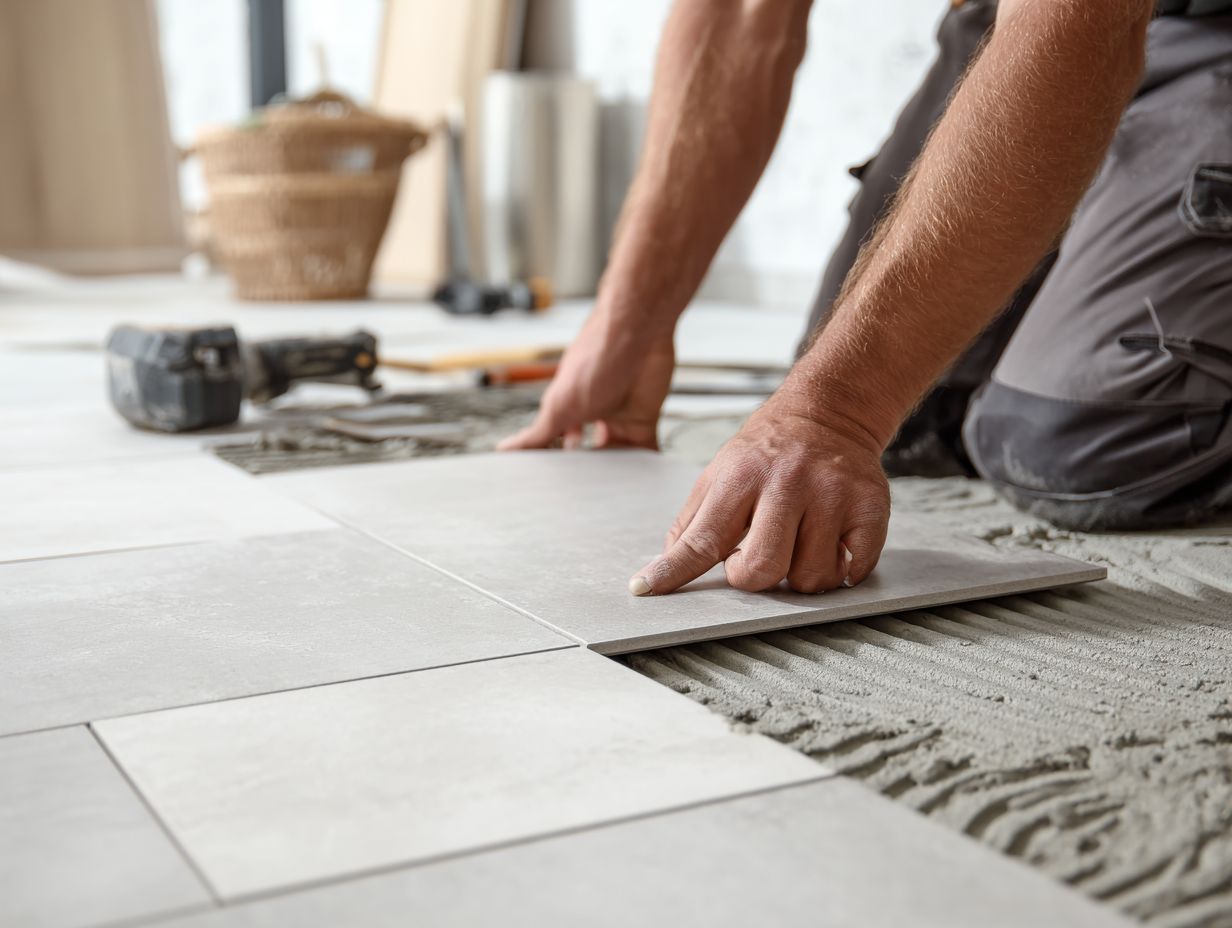
Choosing the right adhesive is critical, with options like TEC and Laticrete designed to support large format tiles and mitigate lippage issues.
Both TEC’s Large Format Tile Mortar and Laticrete’s 254 Platinum are excellent choices. TEC mortar is simple to use and resists shrinking, making it ideal for outdoor projects.
Laticrete 254 Platinum offers superior bonding capabilities, which is especially beneficial for high-traffic areas. When selecting, consider the substrate; for instance, if installing over concrete, opt for a moisture-resistant formula.
Always follow the manufacturer’s instructions for setting time and cure time to get the best results.
Leveling and Alignment Problems
Proper leveling and alignment are important to prevent uneven tile surfaces. This often needs special methods and tools to achieve a smooth result.
- To achieve proper leveling, start by using a reliable laser level to establish reference points.
- Next, mix and pour self-leveling compound as per the manufacturer’s instructions, ensuring an even distribution.
- Tools like a notched trowel can help spread the compound effectively.
- Using a floor flatness meter can help detect minor height discrepancies.
- Frequently inspect the surface as the compound sets, and make changes if needed to keep it level and avoid any uneven edges later.
Tools and Techniques for Installation
Properly installing large tiles requires the right tools and methods to work quickly and achieve top-notch results. For those wondering whether porcelain or ceramic tiles are more suited to their needs, our definitional guide on their composition, cost, and durability offers valuable insights.
Essential Tools for Large Format Tile Installation
Key tools for large format tile installation include RUBI Tools for cutting, levelers for alignment, and trowels for adhesive application.
Besides these, think about buying a wet saw. It helps make exact cuts with less chipping, which is great for cutting porcelain or glass tiles.
A good set of tile spacers keeps grout lines even, and a rubber mallet helps place tiles properly without causing any damage.
Using a laser level improves accuracy over traditional leveling methods.
By concentrating on these tools, you can significantly speed up the installation process and achieve excellent results.
Recommended Installation Methods
Professional installers suggest using the thin-set and large format tile systems for better project efficiency and long-lasting results.
To lay tile with the thin-set method, begin by getting your subfloor ready. Make sure it’s clean and even.
Next, mix your thin-set mortar according to package instructions. Use a notched trowel to spread it evenly on a small section of the floor.
Place your tiles, pressing down firmly to eliminate air pockets, and maintain consistent spacing with tile spacers. For large format tiles, consider using a leveling system to prevent lippage.
This method improves its appearance and increases its durability by reducing cracks.
Best Practices for Successful Installation
Best practices for large format tile installation include ensuring proper acclimatization, using high-quality adhesives, and maintaining a clean workspace.
Make sure the base is dry with a moisture level under 5% before starting the installation.
A level surface is essential; use a level and a straightedge to identify and correct any uneven areas.
When applying adhesive, experts recommend using a notched trowel to achieve an even spread.
Use spacers to keep grout lines even, improving the look and strength.
Regularly stepping back to assess alignment during installation can also help prevent costly mistakes.
Cost Implications
Knowing how large format tile installation affects costs is important for planning your budget and ensuring the project runs smoothly.
Material Costs
Material costs for large format tiles can range from $5 to $15 per square foot, depending on the brand and material type.
Porcelain tiles, known for their durability, typically range from $8 to $12 per square foot; popular options include the MSI brand.
Ceramic tiles are often more economical, costing between $5 and $10 per square foot, with brands like Daltile offering various styles.
For the most high-end choices like natural stone tiles, you might see prices soaring to $15 or more per square foot.
Factor in installation costs as well, which can add another $5 to $10 per square foot, depending on your selected tile contractor.
Labor Costs and Time Considerations
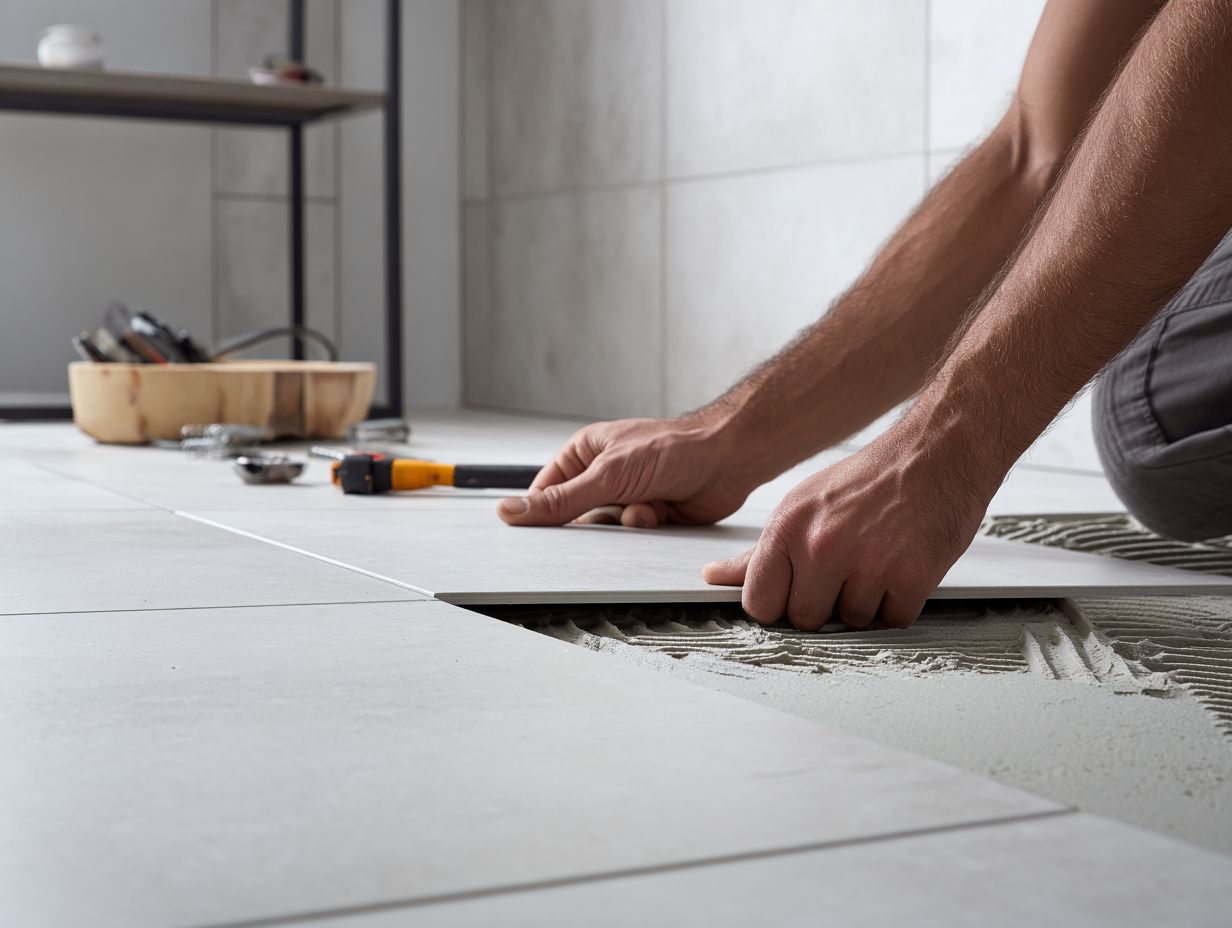
Labor costs for installing large format tiles generally range from $4 to $8 per square foot, with installation time averaging 1 to 2 days for a typical 300 sq. ft. room.
Different things can affect these costs, like how complicated the tile pattern is, what kind of glue is needed, and how much work is needed to get the subfloor ready.
For instance, if the subfloor requires additional leveling or repairs, expect to add an extra $1 to $2 per square foot. Hiring an installer who knows how to work with big tiles can lower the chances of problems later, making the higher cost worthwhile.
Always ask for several quotes to compare prices and make sure you get a good deal.
Summary of Key Points
Key points include the aesthetic appeal, durability, and installation challenges of large format tiles, emphasizing the need for proper techniques.
To get the most out of large format tiles and tackle their difficulties, follow these steps.
- First, make sure your base is completely flat, as any flaws will become more noticeable.
- Next, use a modified thin-set mortar designed for larger tiles to improve adhesion; options like Mapei Ultraflex LFT are highly recommended.
- Buy a big tile cutter for accurate cuts and less damage.
- Maintain grout lines at least 1/16 inch wide to allow for movement.
These practices will help you achieve a stunning and durable tile installation.
The Outlook for Big Tiles in the Market
Large format tiles are becoming more popular in homes and businesses due to continuous improvements.
Changes in design, like improved digital printing, make tiles look more realistic and similar to natural materials.
The introduction of lighter materials has made installation more manageable, reducing labor costs significantly.
For example, the use of porcelain tiles that are just a few millimeters thick can be adhered directly over existing surfaces without the need for complicated underlayment.
These new designs fulfill style needs and tackle environmental issues, helping expand the market for large format tiles.
Frequently Asked Questions
What are large format tiles?
Large format tiles refer to tiles that are larger than the standard size of 12×12 inches. They can range from 12×24 inches to as large as 48×48 inches.
What are the installation challenges with large format tiles?
A key issue is the heavy tiles, which complicates handling and placement during installation. Another challenge is achieving a level and flat surface for the tiles to be installed on.
What are the benefits of using large format tiles?
Large format tiles create a smooth and clean appearance because they have fewer grout lines. They also require less maintenance and cleaning as there are fewer grout lines for dirt and grime to accumulate in.
Do large format tiles require a special installation method?
Large tiles usually need a special way of being put down, like putting adhesive on the back, to stick well and to avoid uneven surfaces. It is important to follow the manufacturer’s installation instructions for the best results.
Can large format tiles be used in any room?
Large format tiles can be used in any room, but they are particularly popular in areas with high foot traffic, such as kitchens, bathrooms, and commercial spaces. They can also be used in outdoor spaces, such as patios and pool decks.
What are the different types of large format tiles?
There are various types of large format tiles available, including porcelain, ceramic, natural stone, and even glass. Each type has its own unique benefits and can be used in different areas of the home or for different design styles.

